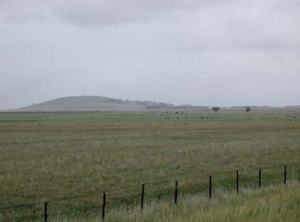CLRA48
|
| CLRA48 |  Epihypersodic, Self-mulching, Grey Vertosol | |
| The Sanctuary (Beal Road), Colac district, south-west Victoria | |||
| Lava plain | |||
| Quaternary paludal lagoon and swamp deposits: silt, clay | |||
| Flat | |||
| 0–1% | |||
| South-west | |||
Horizon | Depth (cm) | Description | ||
A | 0–35 | Black (2.5/N); heavy clay; strong coarse and medium prismatic, parting to medium and fine angular blocky structure; smooth ped fabric; very firm consistence (moist); non-calcareous, pH 7.5; diffuse boundary to: | ||
B21 | 35–80 | Dark grey (2.5Y4/1) with very few fine faint orange mottles; medium heavy clay; strong coarse and medium prismatic, parting to medium and fine angular blocky structure; smooth ped fabric; firm consistence (moist); non-calcareous, pH 9; diffuse boundary to: | ||
B22 | 80–140+ | Dark grey and greyish brown (2.5Y4/1, 2.5Y5/2) with few medium distinct orange mottles; medium clay; very few fine rounded quartz pebbles; strong coarse and medium prismatic, parting to fine angular blocky structure; smooth ped fabric; firm consistence (moist); non-calcareous, pH 9. | ||
| Management considerations | ||||
| This is a structured cracking clay soil. Cracking clay soils vary in their workability depending on their moisture status (highly permeable when dry and impermeable when saturated). These soils are also prone to structure decline particularly when worked wet. They are also generally alkaline with depth and can place stress on roots with their high shrink-swell capabilities. The main priority on these soils is to avoid working when wet (on or below plastic limit). The alkaline subsoils are associated with a high nutrient capacity but result in an imbalance in nutrient availability (may be restrictive to certain plant species (e.g. potatoes). This soil type is often associated with sodic and calcic soil properties, here very sodic, magnesic as well as saline in the subsoil. Growing alkaline tolerant species is a practical option. Soil salinity at depth will affect deeper rooting plants and may indicate water movement restrictions. It is important not to increase the groundwater level bringing the salinity closer to the surface; more efficient use of water by plants and/or deep drainage is suggested. | ||||
Analytical data
Site CLRA48 | Sample depth | pH | EC | NaCl | Ex Ca | Ex Mg | Ex K | Ex Na | Ex Al | Ex Acidity | FC –10kPa | PWP –1500kPa | KS | FS | Z | C | |
Horizon | cm | H2O | CaCl2 | dS/m | % | cmolc/kg | cmolc/kg | cmolc/kg | cmolc/kg | mg/kg | cmolc/kg | % | % | % | % | % | % |
A | 0–35 | 8 | 7.6 | 1.3 | N/R | 6.2 | 26 | 2.5 | 17 | N/R | N/R | N/R | N/R | N/R | N/R | N/R | N/R |
B21 | 35–80 | 8.5 | 8.1 | 2.6 | N/R | 5 | 26 | 2.8 | 38 | N/R | N/R | N/R | N/R | N/R | N/R | N/R | N/R |
B22 | 80–140+ | 8.8 | 8.3 | 2.7 | N/R | 4.5 | 25 | 2.8 | 39 | N/R | N/R | N/R | N/R | N/R | N/R | N/R | N/R |



